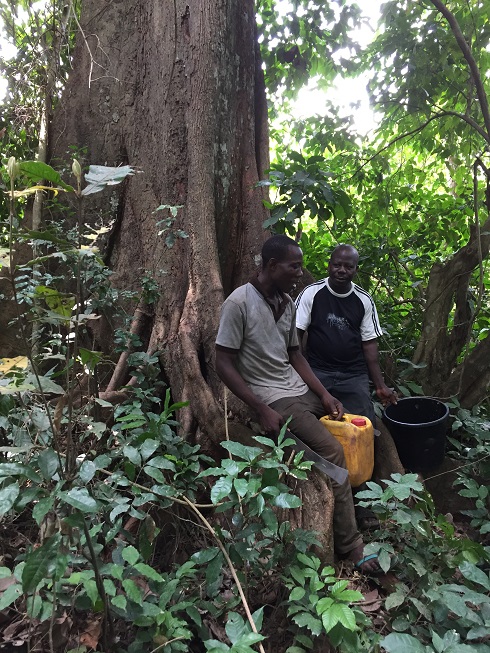
Of all the possible ways to save a primate species from extinction, the least expected is voodoo. It is known as vodun in Benin, West Africa, where Swiss ecologist Peter Neuenschwander began his conservation efforts.
I have written before how Peter first acquired, in 1995, a little group of red-bellied monkeys, a critically endangered species that lives only in the dwindling coastal forests of Benin. Later, Peter started to buy tracts of forest to keep the monkeys. At first, he kept them in cages. But after the monkeys began to mate, the half-grown babies would slip out of the cages and forage in the forest, where they were also fed on cucumbers and bananas, to make sure they got enough to eat.
Peter told me his story when I visited him at his Sanctuaire des Singes (Monkey Sanctuary) in the village of Drabo Gbo, near Cotonou, 12 years ago. Now heâs published a novel, based on his experience, in which he gives more details about how he slowly acquired his 14-hectare forest, buying small plots of about a hectare at a time.
Although Peter enjoyed his research in entomology, and loved living and working in Africa, he swore he would never buy land there. Or at least until a friend took him to Drabo Gbo, a small area near the research station where Peter worked. A large extended family owned a piece of land that had once been natural forest, but was now mainly planted with teak trees. A small area of sacred forest still remained, dominated by a massive cola tree. It was love at first sight. Peter arranged to buy the land with the cola tree, and an adjacent plot recently cleared for maize.

The sale helped the villagers of Drabo Gabo out of an impasse, for they had split into two groups, one of evangelical Christians and one of believers in vodun. The evangelicals wanted to cut down the forest and sell the wood. They also wanted to stop the vodun worshipers holding their rituals beneath the cola tree on moonless nights.
Peter bought the sacred forest from the evangelical faction, which held the title to the land. They got their money and Peter got his land. He then told the vodun group that they could continue to hold their rituals in the forest, but only if they would protect it.
Peter offered more than moral support to the vodun group. He joined in their sessions and, as he acquired more land, he was eventually initiated into two vodun groups, Zan-Gbeto, and Oro. In return, the Zan-Gbeto assigned a young man to be Peterâs guardian. Peter built a house on the deforested land, and with his guardian began to reforest the maize and fallow fields. Fortunately, the land had only recently been cleared from forest. Some trees grew up from the stumps left in the field. Other saplings sprouted from seeds that were still in the soil. Peterâs guardian would also bring in rare tree seedlings that he had found in neighborâs fields.

As Peter describes in his book, it hasnât always been easy. The villagers often ask him for cash to pay for school fees, funerals and medical expenses. He feels that he has to pay or they will turn on the forest, since they think that it would be better used for farming. There has also been violence, including a machete fight fueled by alcohol at a vodun meeting, and even murder.

Yet the villagers essentially held up their end of the bargain. The vodun men kept the hunters and woodcutters out of the forest. Peter could not have protected the forest by himself. There have been other benefits besides providing a home for the monkeys. By 2015 about half of the endangered plants in Benin were to be found in this sacred forest. Some animals, like the royal pythons, have become rare, but the red-bellied monkeys are reproducing. Peter has managed to pass his sanctuary forest on to the International Institute of Tropical Agriculture (IITA), where he still works on a voluntary basis. IITA will use the forest as a place to study insects, which are essential for biological pest control, which is Peterâs specialty.
The sacred forest is now recognized as a reference forest. Botanists can visit and see trees that they may have never seen before, because the forests that still harbor them are too remote.
Many northern scientists who work and live the tropics have done important research. Few have made a home for endangered monkeys in a sacred forest, and by doing so, saved both. Itâs not a job for the faint of heart. Peter is nothing if not honest about his experiences. âThere are times when I hate myself for being here, and detest the entire village.â But he also writes: âAfter years of travelling throughout Africa in a quest to improve sustainable farming, this attraction culminated in a boyâs dream come true: living in a real forest, tending rare plants, and raising endangered monkeys.â
Further reading
Bentley, Jeff 2008 Red-Bellied Monkeys.
Neuenschwander, Peter 2020 Death in Benin: Science Meets Voodoo. Just Fiction! Editions, Omni Scriptum Publ., Beau Basin, Mauritius.
Neuenschwander, P., & Adomou, A. 2017. Reconstituting a rainforest patch in southern Benin for the protection of threatened plants. Nature Conservation 21: 57-82.
Neuenschwander, Peter, Brice Sinsin and Georg Goergen (editors) 2011 Nature Conservation in West Africa: Red List for Benin. Cotonou: IITA.
Neuenschwander, P., Bown, D., HĂšdĂ©gbĂštan, G. C., & Adomou, A. 2015 Long-term conservation and rehabilitation of threatened rain forest patches under different human population pressures in West Africa. Nature Conservation 13: 21â46.
Scientific names
Cola tree, Cola gigantea
Royal Python, Python regius
Red- bellied monkey, Cercopithecus erythrogaster
Acknowledgements
A warm thanks to Peter Neuenschwander for comments on a previous draft, and for kindly allowing me to use his excellent photographs. And to Paul Van Mele and Eric Boa, your help on these stories is always appreciated, even if I donât always say so.






